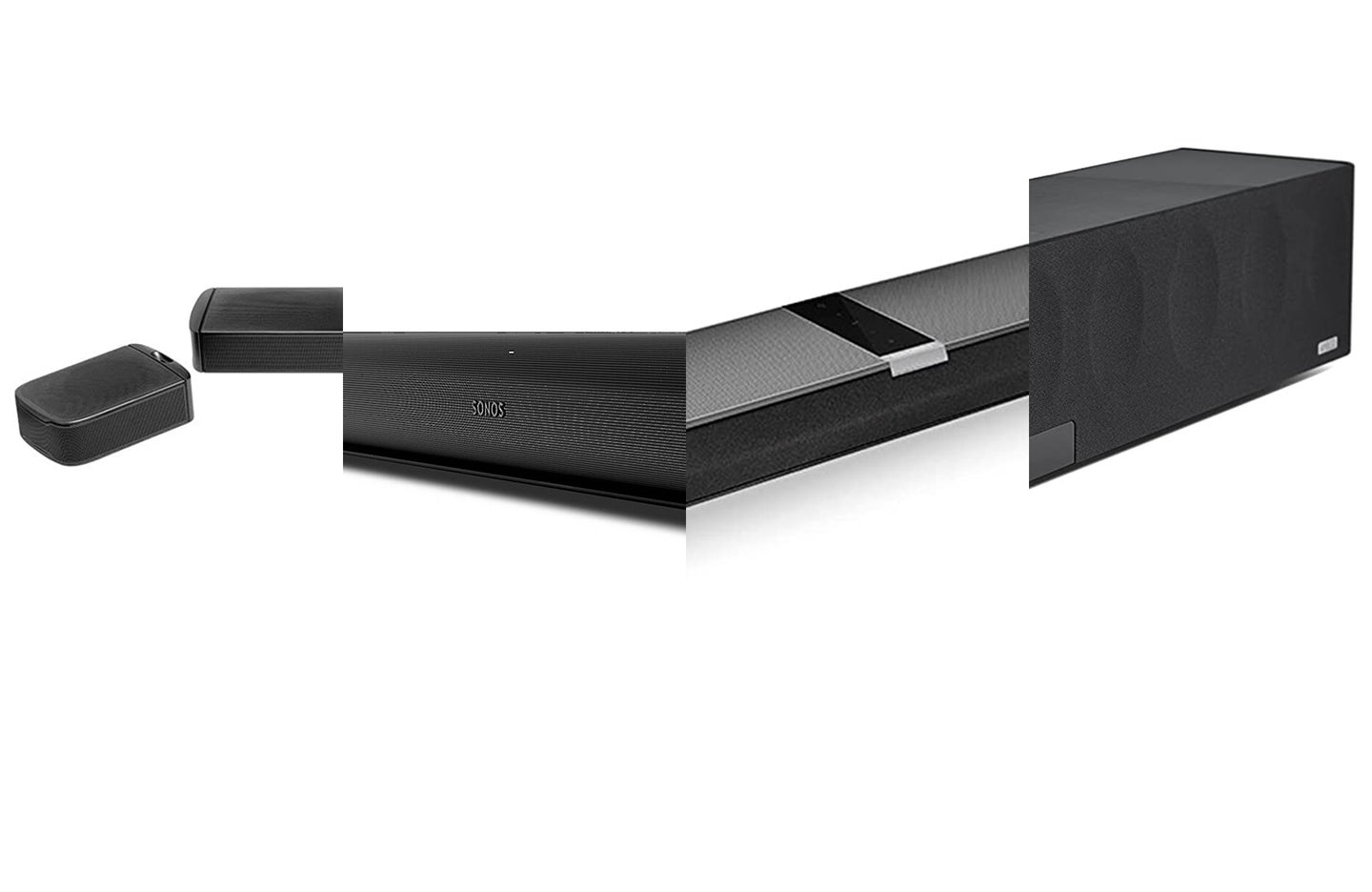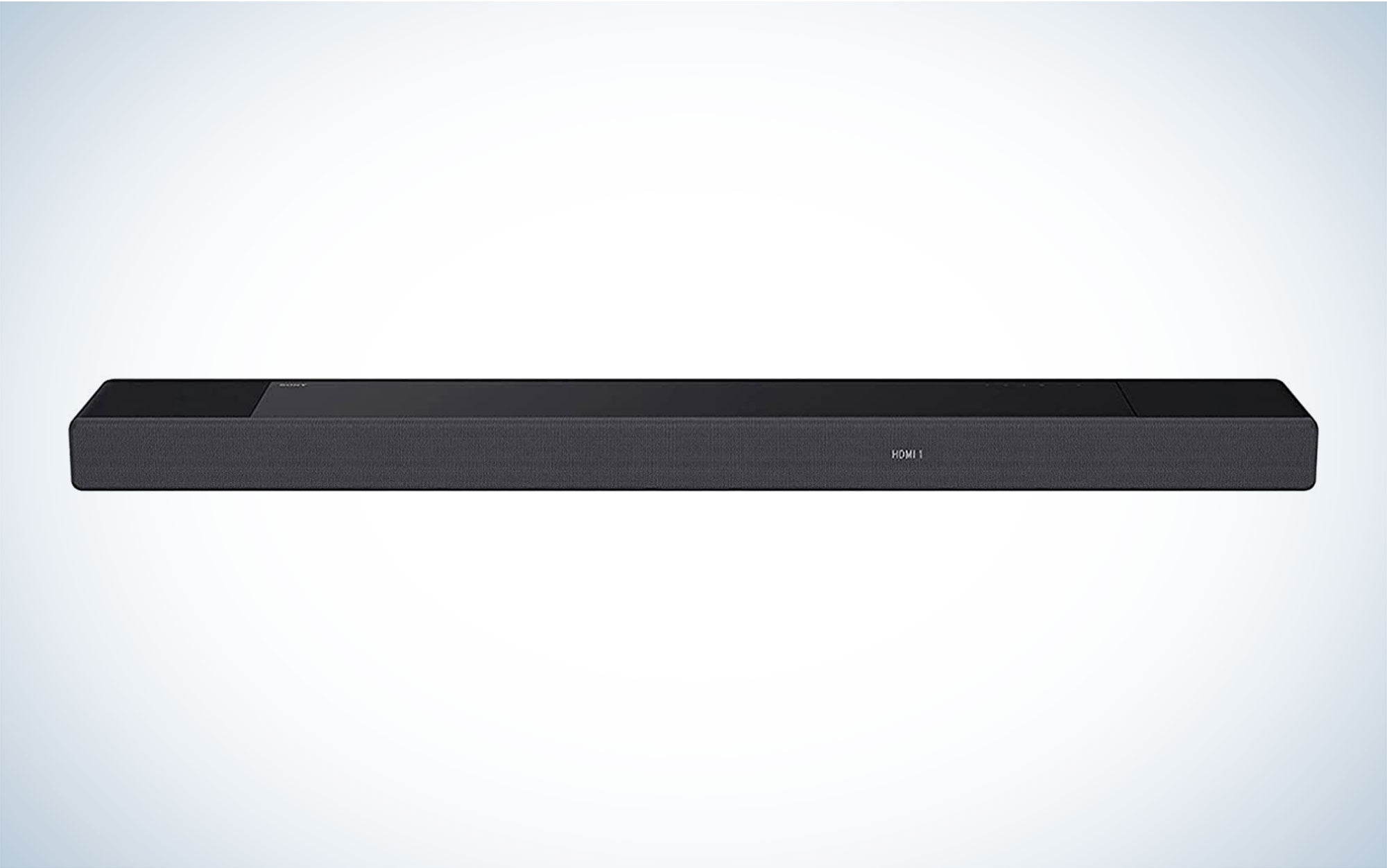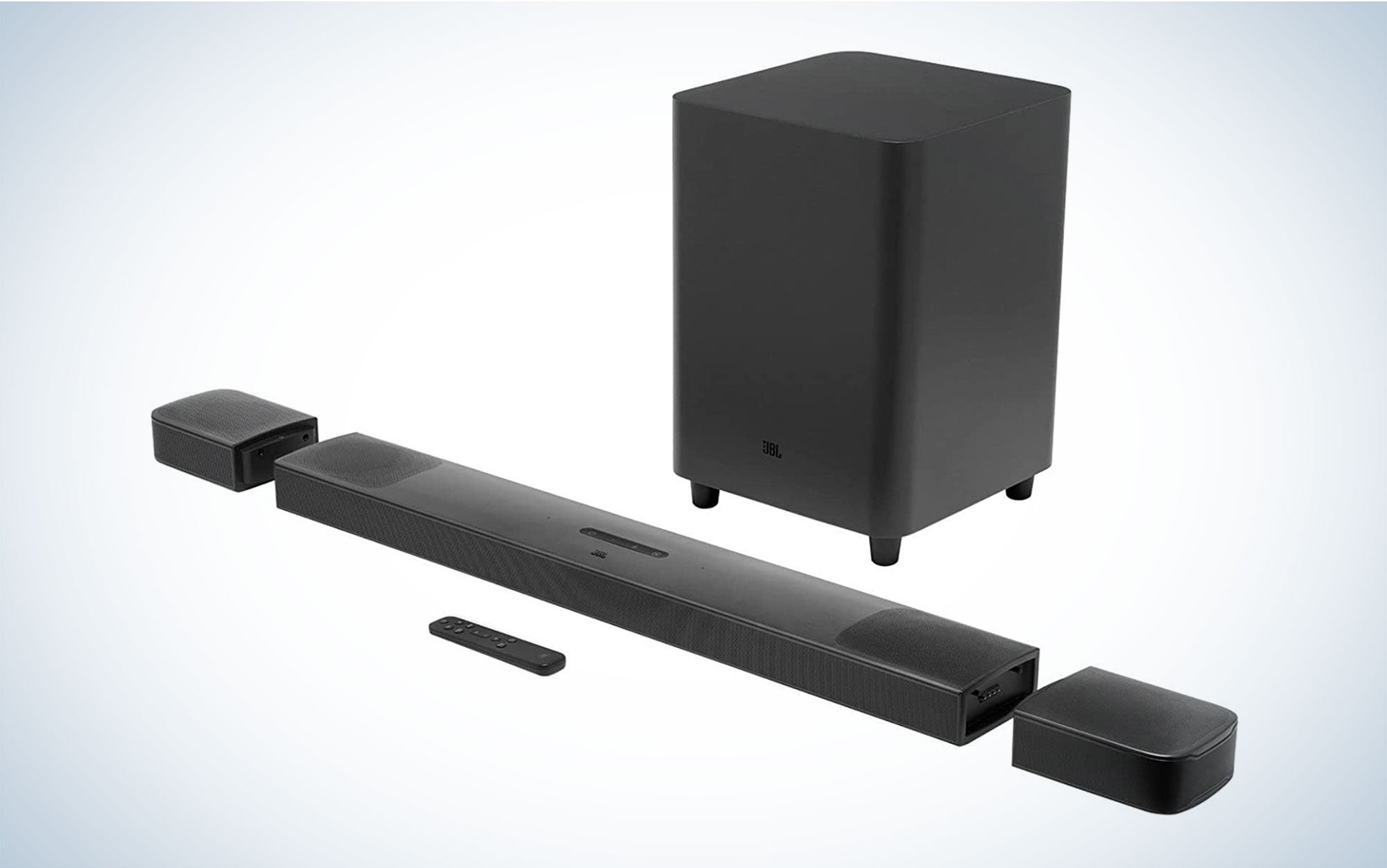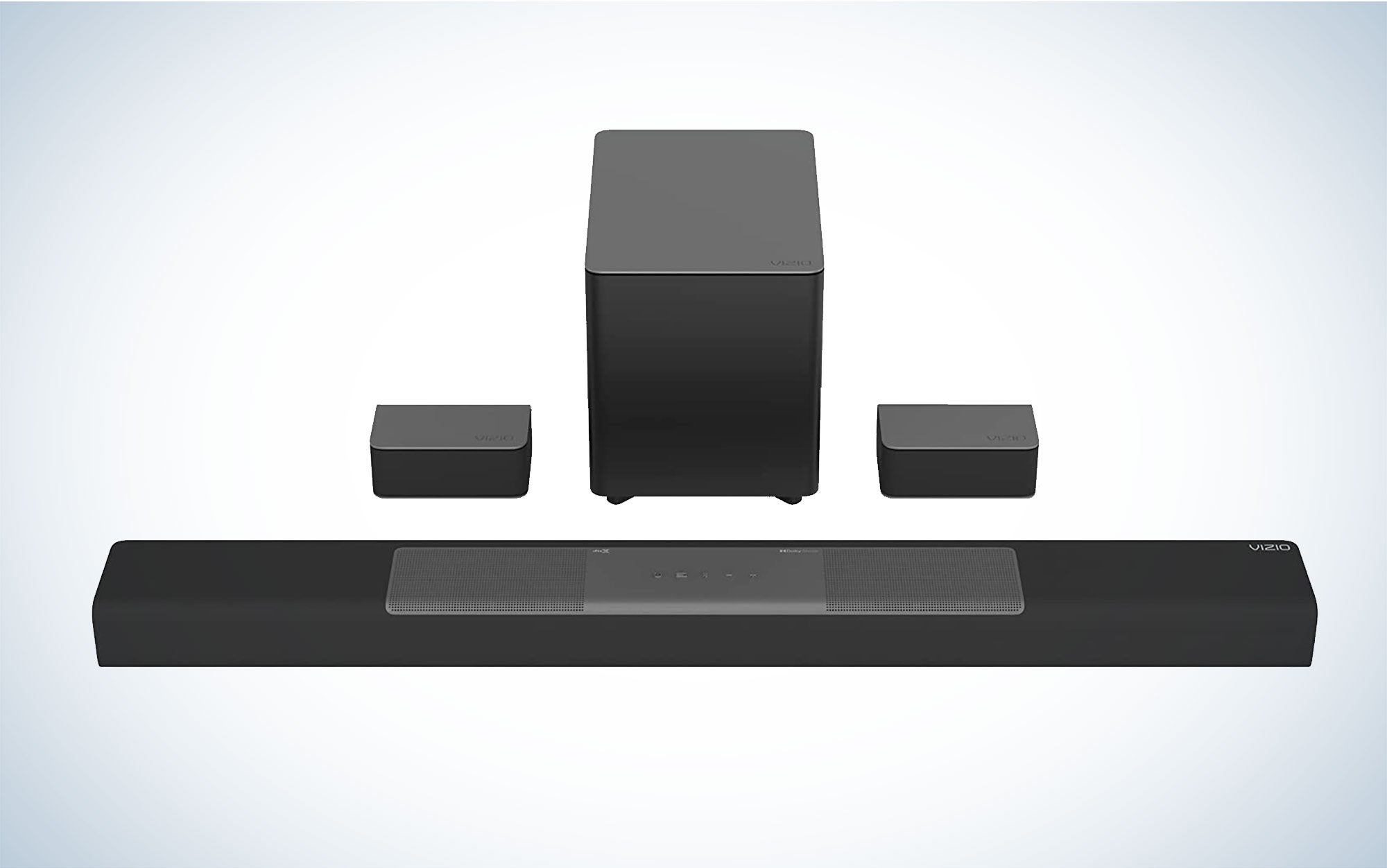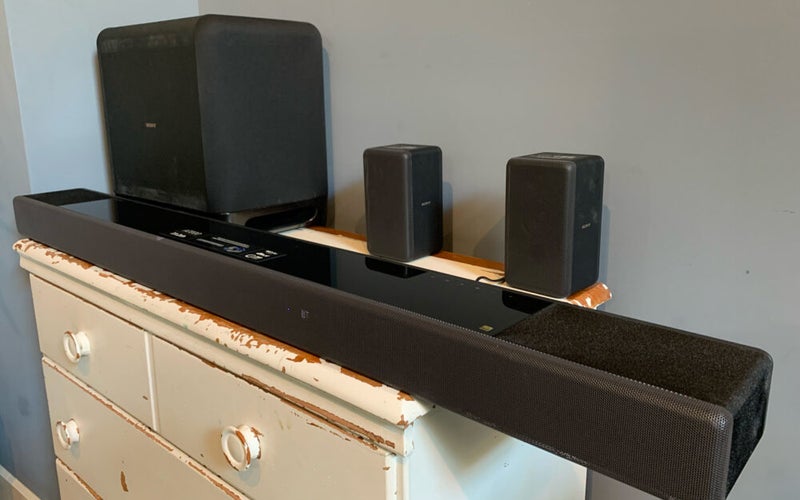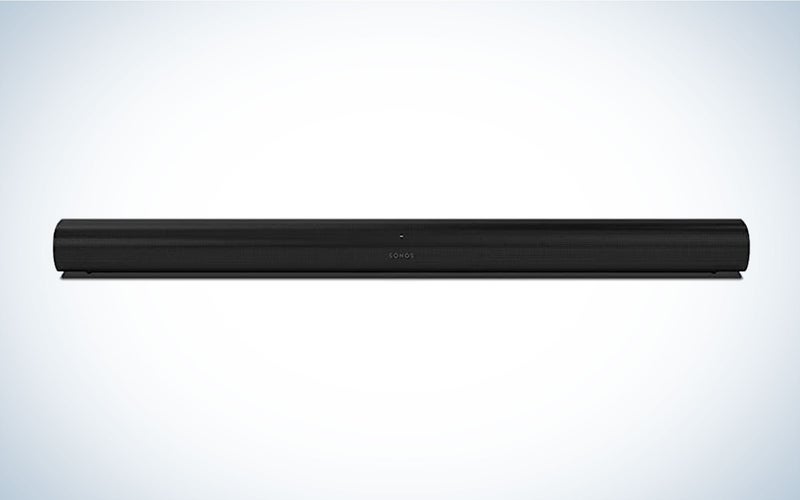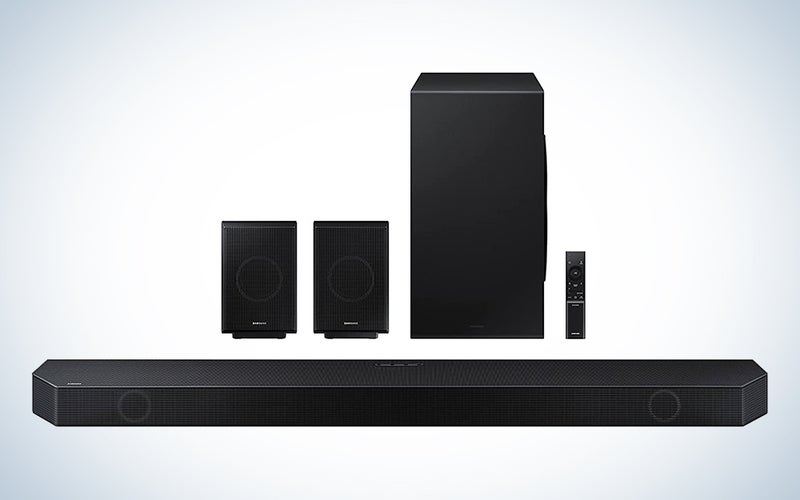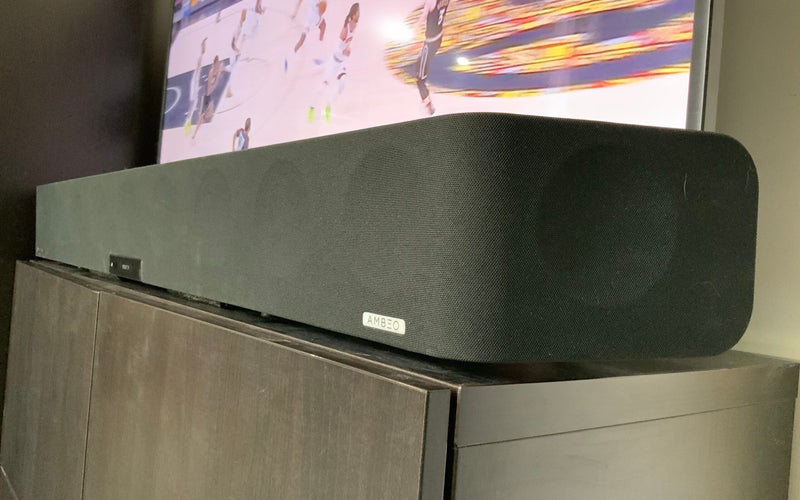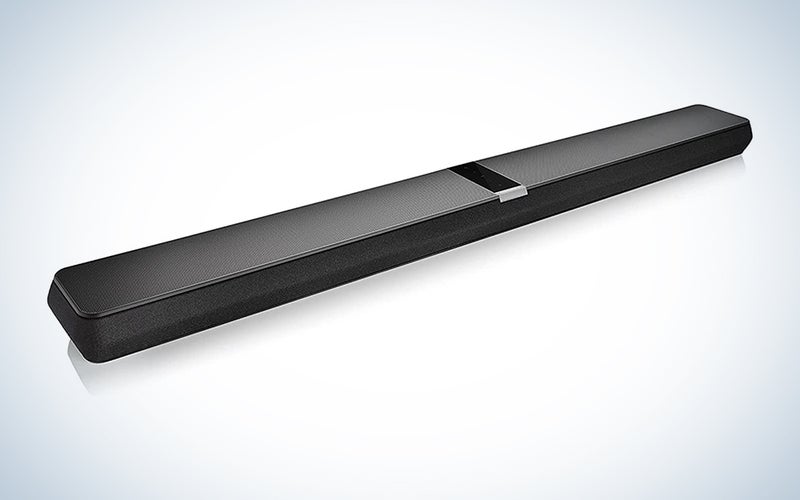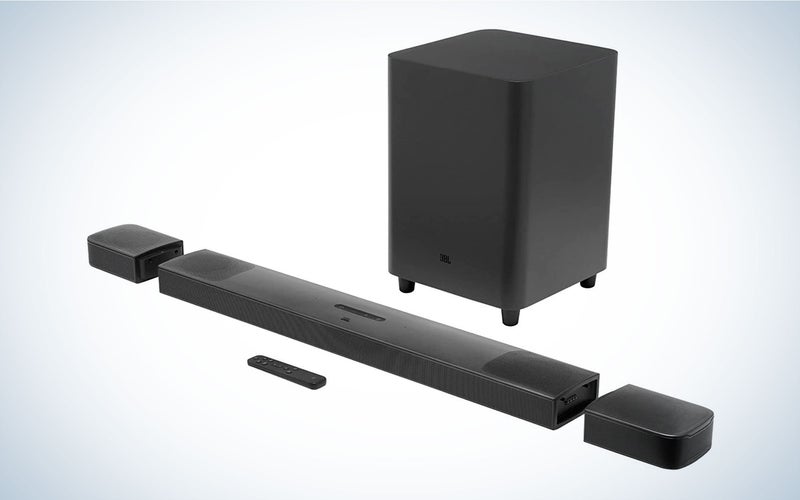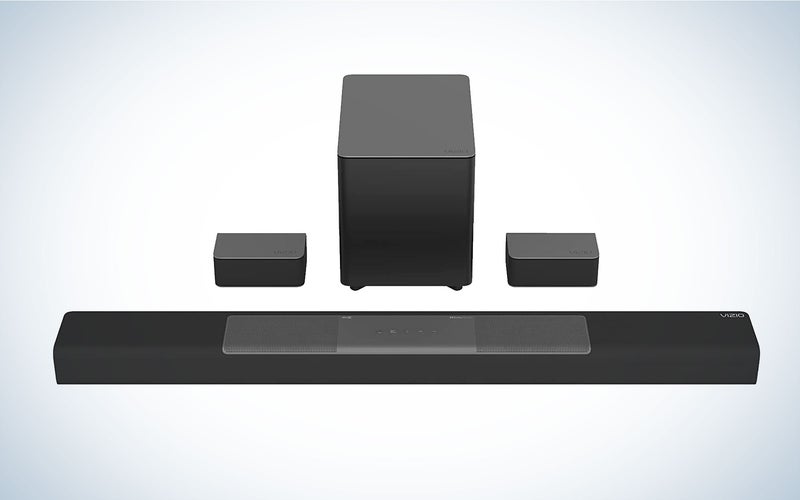We may earn revenue from the products available on this page and participate in affiliate programs. Learn more ›
Soundbars have always been the most convenient way to add better sound to your TV and, with the advent of Dolby Atmos, they have become an even more attractive option for those who don’t want to deal with the hassle of a full surround sound speaker system. Whether it’s an all-in-one unit, or one paired with a subwoofer and satellite speakers, the best Dolby Atmos soundbars can deliver an immersive experience close to what you’d expect from a far more elaborate setup, but without taking over your living room with a receiver, multiple speakers, and endless strings of wires.
While they are often simple to set up and use, choosing best right Atmos soundbars for your needs can get a bit complicated. Their size, features, and performance can vary quite a bit. You’ll want to make sure your investment is a good one. Thankfully, there are plenty of great options to consider, and we’ve collected some of the best ones here that are sure to meet a range of different needs.
- Best overall: Sony HT-A7000
- Best all-in-one for whole-home audio: Sonos Arc
- Best with a subwoofer: Samsung HW-Q990B
- Best high-end standalone: Sennheiser AMBEO MAX
- Best low-profile high-resolution: Bowers & Wilkins Panorama 3
- Best wireless: JBL Bar 9.1
- Best budget: Vizio M-Series M512a-H6
What is Dolby Atmos?
Dolby Atmos is a surround sound technology that creates (or simulates) “3D audio,” where the sounds from your movie, TV show, or video game come from any point around you, including above or below. It first appeared in theaters in 2012 before making its way into home theater gear a few years later, where it’s been widely adopted as one of the most popular platforms for adding positional audio to sound systems.
Atmos dramatically changes the basic approach to how sound systems “place” audio. Instead of simply assigning sounds to channels—usually five, sometimes seven in a standard surround sound setup—an Atmos-enabled system defines well over 100 individual sounds as “objects” that can be precisely directed around a viewing space. The official, theater-grade version of Atmos requires more speakers than your average surround sound system, including ceiling-mounted speakers called “height channels.” Dolby and speaker manufacturers have found a few ways of approximating the experiences without the additional labor wiring and mounting speakers above your couch, ranging from using upward-firing speakers to bounce sound off the ceiling, which is what you’ll find on our soundbar picks to “virtual Atmos” that simulates the experience digitally.
There is enough room for variation that the way in which your speakers choose to apply Atmos can impact the quality of the sound. Our selections feature physical upward- or top-firing speakers designed to bounce sound off your ceiling to provide true 3D audio. We feel that, given the expense of a mid-to-high-range soundbar system, it seems appropriate to get the best possible balance between sound quality and convenience. That said, there are lots of speakers that get tremendous performance out of virtual Atmos, especially in headphones and gaming headsets.
How we chose the best Dolby Atmos soundbars
Buying a soundbar with Atmos can complicate the picking-out process, though it is still an easier process than, let’s say, buying the best bookshelf speakers or standalone speakers for music, as those can require A/V receivers, etc. Even with comparatively limited options, however, Atmos introduces new specs to trip up on, which can make picking one out harder than it needs to be.
Our selections are based on our own in-depth reviews and soundbar testing, as well as impressions from users and the evaluations of other critics. More broadly, I also relied on my own personal experience with home audio gear, which has included testing and covering equipment for sites like Reviewed, Popular Mechanics, and Engadget.
The best Dolby Atmos soundbars: Reviews & Recommendations
Our picks for the best Dolby Atmos soundbars range from the affordable to the extravagant, and from simple to more elaborate options (there are great soundbars you can find for under $500, but the ones on this page primarily represent the upper tier). Whichever you choose, you can expect some of the best Atmos performance in its price range, and a system that you should be able to get up and running with minimal hassle. They are also all versatile speakers and offer at least some basic wireless connectivity and additional features that make them well-suited for playing music or podcasts even when your TV is off, if not full-fledged Alexa or Google Assistant integration.
Best overall: Sony HT-A7000
Why it made the cut: Sony’s HT-A7000 delivers the goods with stellar Atmos performance in an expandable package.
Specs
- Size: 51.25” x 3.25” x 5.63”
- Speaker configuration: 7.1.2
- Connectivity: HDMI (2), Optical, Analog, USB, Wi-Fi, Bluetooth
Pros
- Rich, spacious sound
- Plenty of connectivity options
- Expandable with optional subwoofer and rear speakers
Cons
- Adding a subwoofer and rear speakers gets pricey
Sony’s flagship HT-A7000 soundbar makes a strong impression. It packs an impressive array of integrated speakers designed with spatial audio in mind, including five front speakers, two up-firing speakers that reflect off the ceiling, and two “beam tweeters” that bounce sound off the side walls—a built-in dual-channel subwoofer also adds some bass to the equation.
You’ll also find all the connectivity options you’re likely to need on both the physical and wireless sides of things, the latter of which offers integration with both Amazon Alexa and Google Assistant, as well as support for Chromecast, Spotify Connect, and Apple AirPlay. Like many soundbars, you can add an optional subwoofer and rear speakers if you like, but the soundbar itself is no slouch on its own.
When we tested the Sony HT-A7000, we found that it sounded great and, specifically, that its Atmos speakers amplified movies where you were supposed to hear sounds coming from all around you. What more can you ask for?
Best all-in-one: Sonos Arc
Sonos
Why it made the cut: The Sonos Arc delivers strong sound in one of the most simplified and streamlined Atmos experiences available.
Specs
- Size: 45 x 3.4 x 4.5 inches
- Speaker configuration: 5.0.2
- Connectivity: HDMI (Optical adapter included), Ethernet, Wi-Fi
Pros
- Solid Atmos performance from all-in-one unit
- Loads of smart features
- Sleek, understated design available in black or white
Cons
- Limited connectivity options
Like most of the company’s other speakers, the Sonos Arc delivers high-precision audio in a simple, but costly package. The Arc’s a fairly large soundbar—45 by 3.4 by 4.5 inches—and specifically made to pair with 49-inch TVs or larger (luckily, we recommend the best 55-inch TVs, or the 2nd-generation Sonos Beam if you need a smaller, cheaper soundbar with virtual Atmos). That wide shell houses a whopping 11 internal speakers, including two dedicated height channels, which deliver room-filling sound without needing a separate subwoofer. As with all things Sonos, the Arc will also fit right in as part of a multi-room Sonos speaker setup, and you can add rear speakers and a subwoofer over time.
If there’s a downside, it’s that the Sonos focus on simplicity may go a bit too far for serious technophiles. The Arc only offers Wi-Fi connectivity but not Bluetooth, and physical connections are limited to a single HDMI eARC port (an optical adapter is included for those with older TVs).
Best with a subwoofer: Samsung HW-Q990B
Samsung
Why it made the cut: With more integrated speakers than any other soundbar on this list, Samsung HW-Q990B offers the closest thing to a full-fledged surround sound system in a soundbar-based package.
Specs
- Size: 5.4 x 2.7 x 48.5 inches
- Speaker configuration: 11.1.4
- Connectivity: HDMI (2), Optical, Wi-Fi, Bluetooth
Pros
- Impressive speaker configuration provides room-filling sound
- Ample connectivity and smart features
- Q-Symphony feature boosts sound with compatible TVs
Cons
- Pricey
- Takes up more outlets
With an 11.1.4-channel configuration supported by 22 individual drivers, four of them up-firing, Samsung’s HW-Q990B is more than well-equipped to handle all of the spatial audio that Atmos has to offer, and will get you about as close to a full surround sound setup as you can with a soundbar-based system. Comprised of a premium metal grille-wrapped soundbar, wireless subwoofer, and two rear surround satellite speakers, the HW-Q990B uses built-in SpaceFit Sound+ room correction and adaptive EQ to keep all components in sync and optimized to deliver heightened immersion. Dialogue has plenty of clarity, while the subwoofer’s very substantial rumble reinforces the energy of everything happening on screen—capturing the full dynamic range of any content. Not only does the system do an excellent job of virtualizing a 360-degree sphere from Atmos-encoded Blu-rays and/or streaming services, but it can expand audio you might cast to it via AirPlay 2.
Though it’s not required, the HW-Q990B is an especially good choice if you already have (or are planning to buy) a recent Samsung Q-series TV, as you’ll be able to take advantage of the company’s Q-Symphony feature, which lets the soundbar sync up with the TVs built-in speakers for an even fuller sound. Though we imagine it would be amazing with any of the best QLED TVs.
Got a larger room and want to double down on low notes? The Nakamichi Shockwafe Ultra 9.2.4 eARC SSE Max system comes with two subwoofers, as well as four rear surround channel speakers.
Best high-end standalone: Sennheiser AMBEO MAX
Why it made the cut: It’s a serious investment, but the Sennheiser AMBEO MAX rewards the listener with a level of audio quality and Atmos performance that most other standalone soundbars simply can’t match.
Specs
- Size: 49.8 x 5.3 x 6.7 inches
- Speaker configuration: 5.1.4
- Connectivity: HDMI (3), Optical, RCA, Ethernet, Wi-Fi, Bluetooth
Pros
- Rich, high-fidelity sound from an all-in-one soundbar
- Ample connectivity options
- Suitably high-end appearance
Cons
- Very expensive
- Heavy and tall
The Sennheiser AMBEO MAX is in a class of its own. Sennheiser is no stranger to high-end audio gear, of course, and we found the AMBEO to perform even better than the reputation that proceeded it, which was already towering. When we tested the AMBEO, we found it equally well-suited for use as your primary music-listening speaker as it is for TV, movies, and games. It also has everything you’d expect connectivity-wise, including three HDMI ports, optical and RCA audio, Wi-Fi, and Bluetooth—and, yes, there is also a subwoofer output if you really want to go crazy, though the bar already puts out plenty of rumble. At $2,499 for the soundbar, which is heavy and tall and has certain space constraints, this is more speaker than the average person needs, which is why it isn’t our top pick. If you want the single most compelling all-in-one soundbar, though, the AMBEO is a rich, rewarding investment.
Best low-profile high-resolution: Bowers & Wilkins Panorama 3
Bowers & Wilkins
Why it made the cut: If you believe the music is a key part of movie magic, this soundbar is a perfect way to soundtrack your life.
Specs
- Size: 2.5 x 47.5 x 5.5 inches
- Speaker configuration: 3.1.2
- Connectivity: HDMI eARC, Digital Audio In (Toslink), AirPlay 2, Bluetooth 5.0, Spotify Connect
Pros
- Center-channel focus & clarity
- Capable of surprisingly high volume
- Plug-in-play performance
- Touch-sensitive controls on top
- Alexa voice assistant built-in
Cons
- Limited connectivity and customization
- Narrow surround sound presentation
Stylish and self-contained, Bowers & Wilkins Panorama 3 is a soundbar that is more expressive than it is expansive. While the Sennheiser AMBEO MAX is a chonker that can easily cover more than just a sliver of a standard stand-mounted TV, the Panorama 3 is a far sleeker audiophile-oriented option that has more than enough screen clearance despite housing 13 drivers in its slim chassis (though it is long, so expect it to sit in front of those large-screen legs). Being compact doesn’t mean sacrificing dynamics, however. Featuring three 0.75-inch decoupled titanium-dome tweeters, six 2-inch midrange drivers, two 2-inch up-firing Dolby elevation drivers, and two 4-inch subwoofers, with no option for expandability, the Panorama 3’s strength is in its easily integrated, firmly centered, distortion-free soundstage.
While the action isn’t neglected, music, in particular, is rendered at a muscular pace. Paired with an Apple TV 4K (giving you access to lossless/spatial audio through Apple Music and TIDAL) or the Bowers & Wilkins Music app, the Panorama 3 has attack and control, richness and rhythm. The crisp, punchy tuning is expressive without the soundbar itself being intrusive. The Panorama 3 may not have the most-pronounced Dolby Atmos effects, but it’s articulate and more than capable of laying nuanced ambiance out in front of you.
Best wireless: JBL Bar 9.1
JBL
Why it made the cut: Rear speakers may now be increasingly common in soundbar packages, but the JBL Bar 9.1 offers a convenient completely wireless solution.
Specs
- Size: 34.8 x 2.4 x 4.7 inches
- Speaker configuration: 5.1.4
- Connectivity: HDMI, Optical, USB, Ethernet, Wi-Fi, Bluetooth
Pros
- Detachable, battery-powered satellite speakers
- Large subwoofer provides plenty of bass
- Easy to set up
Cons
- Convenience comes at a bit of a premium
- Wired speakers may make more sense for some rooms
Most wireless surround sound systems aren’t completely untethered. Many feature “wireless” satellite speakers that don’t need to be connected to a receiver or soundbar, but still need to be plugged into a power outlet. The JBL Bar 9.1 gets extra credit for offering a true wireless option with two detachable, battery-powered speakers that can be placed anywhere while you’re watching a show or movie, and then simply be re-attached to the main soundbar to recharge. The speakers get 10 hours of battery life, which is more than enough for most viewing sessions. Luckily, that’s far from the soundbar’s only selling point. Reviews have consistently praised the Bar 9.1’s rich bass and room-filling sound that’s bolstered by its large subwoofer.
Best budget: Vizio M-Series M512a-H6
Vizio
Why it made the cut: Vizio offers another great value for the money with the M512a-H6, which offers an ideal entry point to Atmos with an affordable, easy-to-set-up system.
Specs
- Size: 40.00 x 2.68 x 4.07 inches
- Speaker configuration: 5.1.2
- Connectivity: HDMI, Optical, Analog, USB, Bluetooth
Pros
- Affordable
- Rear speakers included
- Easy to set up
Cons
- No Wi-Fi
- Rear speakers are wired to subwoofer
Vizio makes some fairly high-end gear, but the company is best known for its more affordable gear that tends to offer some of the best value you’re likely to find for the money. That’s just as true for soundbars as it is for TVs. The company’s M-Series M512a-H6 isn’t the least expensive soundbar you’ll find, but it is among the most affordable that offers a true Atmos experience with up-firing speakers. You’re also getting a lot of hardware for the pair of wired satellite speakers and a separate subwoofer.
Reviews praise the M512a-H6’s sound quality and easy setup, but there you should expect some trade-offs in this price range. The M-Series M512a-H6, for example, only features Bluetooth wireless connectivity, not Wi-Fi. That means no Chromecast or AirPlay support, and no Alexa or Google Assistant integration.
What to consider before buying the best Dolby Atmos soundbars
Finding the best Dolby Atmos soundbars isn’t that much different from picking any other sound system. You want to think about sound quality, your viewing space, and what you really need, features-wise, as the upper limits on home theater audio spending will scale as high as you let them. These are a few basic ideas we think you should keep in mind when picking out the best Dolby Atmos soundbars for you.
Take a look at the ceiling
As with any speaker, the actual room a soundbar is in, and the placement of the soundbar, can have a considerable impact on the sound. With Atmos and soundbars with upward-firing speakers bouncing sound off the ceiling, that becomes even more important. Dolby recommends a flat 7.5- to 12-foot-tall ceiling, and you’ll want to make sure that nothing (including your TV) gets in the way of the upward-firing speakers. Obviously, most of us aren’t in a position to adjust or switch our living room up for the sake of our sound system. If you have a low and/or not-flat ceiling over your soundbar, keep an eye out for models with calibration tools that can help you take the extra steps needed to make your system sound the best it can.
Do you want an all-in-one soundbar or a more elaborate system?
Though it’s a bit counterintuitive, a soundbar is always an all-in-one speaker system. There are soundbars that come with subwoofers and others that feature rear and/or side speakers for all-encompassing surround sound. In a multi-speaker system, the soundbar often serves as the front three speakers of a 5.1 or 7.1 speaker system.
Just like the decision between a soundbar and other speakers, picking the number of speakers is really a question of convenience and price, versus superior sound quality. An all-in-one soundbar is the most convenient option and usually more affordable, but pairing a soundbar with a subwoofer will give you more bass and a richer, fuller sound. Installing rear satellite speakers takes a little extra time and planning, but turns a surround sound simulation into the real thing. Generally speaking, even the most complex speaker system is pretty to set up, especially for systems that feature wireless rear speakers.
How will you connect it to your TV?
We have a complete guide for how to connect a soundbar to a TV, but there are a few basics to keep in mind before you buy a soundbar. The most important for Atmos soundbars, in particular, is that your TV should have an HDMI eARC port to get the most out of your soundbar and your Atmos content (and make that an HDMI 2.1 port if you’re going to patch in gaming consoles). The “eARC” part stands for Enhanced Audio Return Channel and it’s just that: an improved standard that offers more features and more bandwidth.
You can connect most of the soundbars here with a standard HDMI cable or optical cable, but you’ll need an eARC port to take advantage of the highest bit rates and all of the features that Atmos has to offer. The bad news is that eARC is a relatively recent standard and has only been included on TVs since 2018. If your TV doesn’t support it, you can always invest in one of these soundbars now and then take advantage of the full Atmos experience whenever you do eventually upgrade your TV, but it’s something to keep in mind if you’re not looking to buy a new TV anytime soon.
Does it support a virtual assistant?
For many people, a soundbar is also going to be the main speaker system in their home or apartment, which can make features that may seem extraneous to some all the more important. If you regularly use smart speakers with Amazon Alexa or Google Assistant, for instance, you may want to look for a soundbar that supports the same virtual assistant. Bluetooth has also become a standard feature on most soundbars, but Wi-Fi connectivity can offer a number of advantages, including better sound quality and support for wireless streaming via Apple AirPlay or Google Chromecast.
FAQs
Q: Does Dolby Atmos really make a difference?
You’ll notice when a good soundbar supports Atmos. While it won’t completely match a room full of speakers, an Atmos soundbar with up-firing speakers can still get pretty close to that experience. There have been many hyped-up audio formats over the years, but Dolby Atmos has really changed things. Unlike traditional surround sound systems that rely on channels to direct sound around a room, Atmos’ object-based audio can precisely place sounds at any point in 360-degree space, and not simply sound like they’re coming from left or right, front or rear channels. With a full theater-like setup, including in-ceiling speakers, the effect can be completely immersive and make it seem like you are in the center of the action of what’s happening on screen. Or step up to a truly premium all-in-one soundbar like the Sennheiser AMBEO and get that immersive experience without having to place another component or string a single wire.
Q: Is a soundbar better than a surround sound system?
A properly set-up surround sound system will almost always outperform a soundbar—even one with a subwoofer and added rear speakers—but that performance is dependent on how much of your time, money, and space you’re willing to dedicate to your home theater. For most people, the trade-offs that come with a soundbar are more than acceptable, and the best ones can get you close to theater-like sound with minimal disruption to your living space.
Q: Are high-end soundbars worth it?
Not surprisingly, the answer to this question won’t be the same for everyone. As with any speaker system, higher-end soundbars will give you a level of performance that more affordable options simply can’t match. That said, home theater owners who aren’t already veteran audiophiles will likely find a sweet spot that sounds great for them well below the highest-quality gear. For the average listener, a $3,000 soundbar probably won’t sound three times better than a $1,000 soundbar. It sounds noticeably better, however, and that added performance will be worth the extra $2,000 for some. The value of any specific upgrade comes down to personal taste.
Final thoughts on the best Dolby Atmos soundbars
- Best overall: Sony HT-A7000
- Best all-in-one for whole-home audio: Sonos Arc
- Best with a subwoofer: Samsung HW-Q990B
- Best high-end standalone: Sennheiser AMBEO MAX
- Best low-profile high-resolution: Bowers & Wilkins Panorama 3
- Best wireless: JBL Bar 9.1
- Best budget: Vizio M-Series M512a-H6
For many people, Atmos-equipped soundbars should hit the sweet spot for TV audio, balancing convenience and cost, versus sound quality and enhanced immersion. The best Dolby Atmos soundbars offer a truer surround sound experience than more limited soundbars and come in a package that’s far more convenient than a multi-part surround sound setup. Now that Atmos is a few years old, plenty of great soundbars support the format, making it a viable upgrade for most people interested in a soundbar. The key, as always, is identifying the features you care about most, and investing wisely.
Why trust us
Popular Science started writing about technology more than 150 years ago. There was no such thing as “gadget writing” when we published our first issue in 1872, but if there was, our mission to demystify the world of innovation for everyday readers means we would have been all over it. Here in the present, PopSci is fully committed to helping readers navigate the increasingly intimidating array of devices on the market right now.
Our writers and editors have combined decades of experience covering and reviewing consumer electronics. We each have our own obsessive specialties—from high-end audio to video games to cameras and beyond—but when we’re reviewing devices outside of our immediate wheelhouses, we do our best to seek out trustworthy voices and opinions to help guide people to the very best recommendations. We know we don’t know everything, but we’re excited to live through the analysis paralysis that internet shopping can spur so readers don’t have to.
